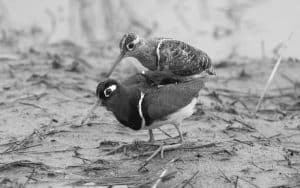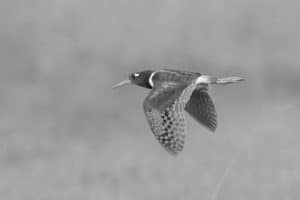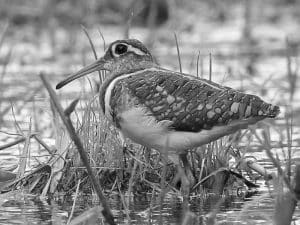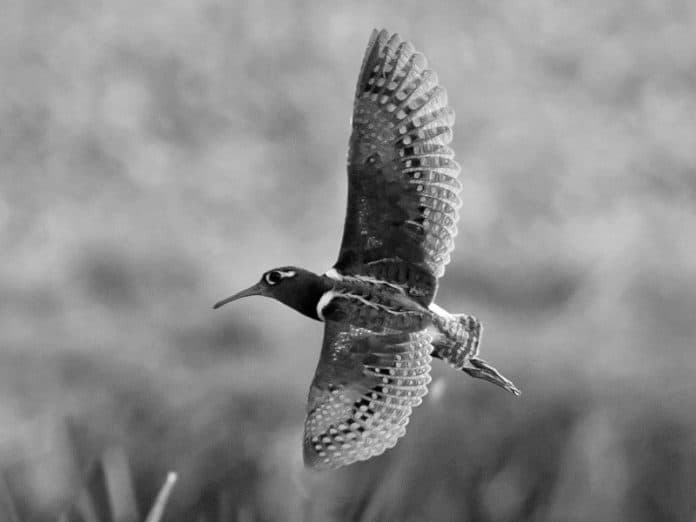Introduction to the Greater Painted-Snipe
The Greater Painted-Snipe (Rostratula benghalensis) is a stunning bird species that can be found in the beautiful country of Tanzania. This magnificent bird is known for its elegant appearance and unique behaviors, making it a popular choice for birdwatchers and nature enthusiasts. In this article, we will explore the habitat, distribution, physical characteristics, behavior, breeding habits, nesting behavior, threats, conservation efforts, best places to spot, and interesting facts about the Greater Painted-Snipe in Tanzania. Join us on this journey as we delve into the world of this remarkable avian species.
Habitat and Distribution of the Greater Painted-Snipe in Tanzania

The Greater Painted-Snipe inhabits a variety of wetland habitats throughout Tanzania. From freshwater marshes and swamps to the edges of lakes and rivers, these birds can be found in areas with dense vegetation and shallow water. They are particularly attracted to areas with floating vegetation, where they can find food and shelter. The Greater Painted-Snipe is widely distributed across Tanzania, with sightings reported in regions such as the Serengeti, Selous Game Reserve, Lake Manyara, and the Rufiji River Delta. These areas provide the perfect environment for these beautiful birds to thrive.
Physical Characteristics and Behavior of the Greater Painted-Snipe
The Greater Painted-Snipe is a medium-sized bird, measuring around 9 to 10 inches in length. It has a distinctively long, straight bill that is used to probe the muddy substrate in search of small invertebrates, such as insects and crustaceans. The male and female of this species exhibit sexual dimorphism. The male is adorned with a vibrant plumage, featuring a black head, neck, and breast, while the rest of its body is a stunning combination of white, brown, and chestnut colors. The female, on the other hand, has a more subdued appearance with brownish feathers and intricate patterns. Both sexes possess large, round eyes that aid them in their nocturnal feeding habits.
The Greater Painted-Snipe is a solitary bird that is known for its cryptic behavior. It spends much of its time hidden among the vegetation, relying on its excellent camouflage to blend in with its surroundings. This behavior makes it challenging to spot these birds in the wild. However, if you are patient and observant, you may be lucky enough to catch a glimpse of their elegant movements as they forage for food or perform their unique courtship displays. They are also known for their distinctive “chip-chip” calls, which can be heard during the breeding season.
Breeding Habits and Nesting Behavior of the Greater Painted-Snipe
Breeding season for the Greater Painted-Snipe typically occurs during the wet season in Tanzania, when water levels are high, and food resources are abundant. During this time, the males engage in elaborate courtship displays to attract females. These displays involve a series of movements, including wing-flapping, head-bobbing, and vocalizations. Once a pair has formed, the female constructs a nest on the ground, usually concealed among the vegetation. She lays a clutch of 3 to 5 eggs, which she incubates for about three weeks. The male often assists in incubation and rearing of the chicks.
The nesting behavior of the Greater Painted-Snipe is fascinating. The female builds the nest by scraping a shallow depression in the ground and lining it with leaves, grass, and other materials. This nest is well-hidden and provides protection for the eggs and chicks. The female also employs a unique strategy to further protect her nest – she covers the eggs with material such as leaves or twigs whenever she leaves the nest unattended. This behavior helps to camouflage the eggs and reduce the chances of predation.
Threats and Conservation Efforts for the Greater Painted-Snipe in Tanzania
Despite its remarkable beauty, the Greater Painted-Snipe faces several threats to its survival in Tanzania. Habitat loss and degradation due to human activities, such as agriculture, urbanization, and pollution, pose significant risks to these birds. Wetland drainage and the spread of invasive species further contribute to the decline in their population. Additionally, hunting and trapping for the illegal bird trade also pose a threat to the Greater Painted-Snipe.
To combat these challenges, various conservation efforts have been implemented in Tanzania. The establishment of protected areas and wetland conservation initiatives aim to safeguard the habitats of the Greater Painted-Snipe and other vulnerable species. Efforts are also being made to raise awareness among local communities about the importance of conserving these birds and their habitats. By promoting sustainable practices and encouraging responsible tourism, we can help ensure the long-term survival of the Greater Painted-Snipe in Tanzania.
Best Places to Spot the Greater Painted-Snipe in Tanzania

If you’re eager to catch a glimpse of the Greater Painted-Snipe in Tanzania, there are several prime locations where you stand a good chance of spotting this elusive bird. The Serengeti National Park is a popular destination for wildlife enthusiasts, and its wetland areas are known to attract the Greater Painted-Snipe. Lake Manyara National Park, with its diverse birdlife and beautiful scenery, is another excellent spot to look for this species. The Selous Game Reserve and the Rufiji River Delta are also worth exploring, as they provide suitable habitats for the Greater Painted-Snipe.
When searching for the Greater Painted-Snipe, it’s important to remember that they prefer areas with dense vegetation and shallow water. Look out for floating vegetation, such as water lilies and reeds, as these are often favored by these birds. Patience and keen observation skills are essential, as the Greater Painted-Snipe is skilled at hiding among the vegetation. Be prepared to spend time scanning the surroundings and listening for their distinctive calls. With a bit of luck and perseverance, you may be rewarded with the sight of this elegant bird in its natural habitat.
Tips for Birdwatching and Photographing the Greater Painted-Snipe
Birdwatching and photographing the Greater Painted-Snipe can be a rewarding experience. Here are some tips to enhance your chances of success:
- Research and Plan: Before embarking on your birdwatching adventure, familiarize yourself with the habitat and behaviors of the Greater Painted-Snipe. Plan your trip accordingly, taking into account the best seasons and locations for sightings.
- Use Appropriate Gear: Invest in a good pair of binoculars and a camera with a telephoto lens to observe and capture the beauty of these birds up close. A tripod can also be useful in stabilizing your camera for sharp images.
- Be Patient and Observant: The Greater Painted-Snipe is a master of camouflage, so be patient and take your time to scan the surroundings. Look for any movement or signs of the bird’s presence, such as rustling vegetation or its distinctive calls.
- Respect their Habitat: When observing the Greater Painted-Snipe, maintain a respectful distance and avoid disturbing their natural behavior. Stick to designated paths and avoid trampling on sensitive vegetation.
- Learn from Local Guides: Consider hiring a local birding guide who can share their knowledge and help you navigate the best spots for birdwatching. They can also provide insights into the behavior and ecology of the Greater Painted-Snipe.
Interesting Facts about the Greater Painted-Snipe

As we continue our exploration of the Greater Painted-Snipe, here are some intriguing facts about these remarkable birds:
- The Greater Painted-Snipe is primarily a nocturnal bird, relying on its excellent vision to navigate and find food in the dark.
- Despite their name, these birds do not actually belong to the snipe family. They are classified in their own unique family, Rostratulidae.
- The Greater Painted-Snipe has a specialized bill that allows it to probe the muddy substrate for food. The bill is sensitive to touch, helping the bird locate prey.
- Both male and female Greater Painted-Snipes are involved in incubating the eggs and caring for the chicks. This shared responsibility is relatively uncommon among bird species.
- The Greater Painted-Snipe is a long-distance migratory bird, with some individuals traveling thousands of kilometers between breeding and non-breeding grounds.
Other Bird Species Found in the Same Habitat as the Greater Painted-Snipe
The habitat of the Greater Painted-Snipe in Tanzania is home to a diverse array of bird species. Some of the other notable avian residents include:
- African Jacana (Actophilornis africanus): This wading bird is known for its incredibly long toes, which enable it to walk on floating vegetation.
- Grey Crowned Crane (Balearica regulorum): With its majestic appearance and distinctive golden crown, this crane is a sought-after sight in wetland areas.
- Malachite Kingfisher (Corythornis cristatus): This small, colorful bird is often seen perched on branches near water bodies, waiting to dive in and catch its prey.
- African Fish Eagle (Haliaeetus vocifer): This iconic bird of prey is frequently spotted near lakes and rivers, soaring high in the sky or perched on tree branches.
Conclusion: Preserving the Beauty of the Greater Painted-Snipe in Tanzania
The Greater Painted-Snipe is a true gem of Tanzania’s avian diversity, with its elegant appearance and unique behaviors captivating the hearts of birdwatchers and nature enthusiasts. However, this magnificent bird faces numerous threats due to habitat loss, hunting, and other human activities. It is crucial that we take action to preserve the habitats and protect the Greater Painted-Snipe and other vulnerable species.
By supporting conservation efforts, promoting sustainable practices, and raising awareness, we can ensure that future generations have the opportunity to marvel at the beauty of the Greater Painted-Snipe in Tanzania. Let us embrace the elegance of this remarkable bird and work towards its preservation and the safeguarding of its natural habitats. Together, we can make a difference and ensure the survival of this magnificent species for generations to come.


































